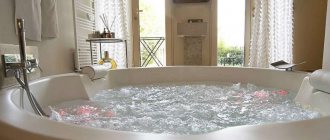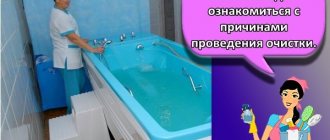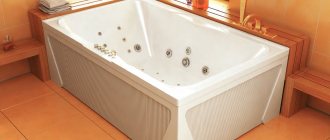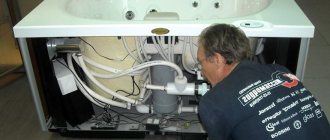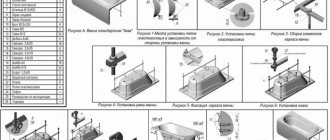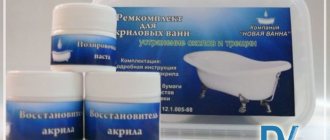As plumbing fixtures are used, their appearance deteriorates. This occurs due to soap deposits, dust, and other contaminants. To avoid having to use aggressive products to remove stubborn stains, it is recommended to ensure regular maintenance of your plumbing fixtures. First you need to decide how to clean the bathtub white at home, then study the instructions for use. This will prevent the coating from being destroyed.
Stubborn dirt in the bathroom.
Preparing for cleaning
There are universal and highly specialized means. They are used for different purposes. For example, substances of the first group will help get rid of any kind of stubborn dirt. Highly specialized ones, on the contrary, remove only some stains. For this reason, you must first determine the type of contamination, which will increase the effectiveness of the detergent. Possible options:
Rust may appear due to a breakdown of common house pumping equipment.
- lime: traces of water drops remain on the mixer and the surface of the bowl, the reason lies in its increased hardness;
- soap scum: this leaves stains of different colors (which depends on the shade of the soap) or a whitish film covering the entire bowl; it forms during the process of taking a shower or bath;
- rust: a consequence of a breakdown of common house pumping equipment or replacement of communications; sometimes low-quality water is supplied to the facility;
- mold - develops in conditions of high humidity and when air circulation is disrupted;
- colored spots are a consequence of careless hair dyeing at home, brilliant green or potassium permanganate is spilled;
- traces of repair (plaster, cement mortar, sealant, polyurethane foam, etc.).
Depending on the nature of the contamination, a cleaning method is selected. In this case, you need to take into account the properties of the bowl’s coating. If you do not follow these recommendations, you can ruin your plumbing. Use acidic materials and powders with caution. The latter are characterized by abrasive properties and will easily damage the coating of the plumbing bowl.
Factors that influence the formation of plaque in the bathtub
The appearance of stains is influenced by two main factors. The main one is water. From the stains you can determine what quality the liquid is in the apartments:
- if yellowish stains have formed, it contains impurities, chlorine compounds or metal molecules;
- the appearance of brown, reddish stains, rust is iron, it’s time to change outdated plumbing fixtures;
- cloudy sediment indicates hard calcined water.
The second factor is dirt and dampness. Splashes and stains from toothpaste remain everywhere, including on the tiles. A soap scum appears on the surface that needs to be scrubbed off. After use, you must clean the bathtub with soap or liquid detergent and wipe dry. Then you won't have to remove stubborn stains.
Cleaning methods without using chemicals
Ways to clean a bathtub at home.
To remove traces of various substances from the surface of the bathtub, remove plaque and rust, it is first recommended to use effective home remedies.
They differ from specialty chemicals in that they work gently. The coating will remain intact even after repeated use of substances prepared based on folk recipes.
However, this method also has disadvantages, such as low efficiency. With their help, you can wipe off fresh stains and remove light dirt. Moreover, increasing the dose of active components will not provide the required result.
Lemon acid
This product is moderately aggressive. The acid helps remove traces of rusty water. It will not remove complex stains, but it can significantly lighten the coating. It is necessary to use the acid correctly, which will increase its level of effectiveness. They use methods based on exposure to a concentrated solution and water containing a small amount of the substance. They are used in different cases. Algorithm of actions:
- Prepare a concentrated solution. To do this, stir 1 packet of acetic acid in 1 glass of water (250 ml). All surfaces of the plumbing fixture bowl are treated with the substance, but it is best to clean those areas where the yellow coating is more visible. Then the bath is left in this state for half an hour. During this time, the acid will penetrate the surface layer of the coating and destroy the contaminants. After half an hour, the product must be washed off the walls of the bowl.
- Use of a low concentration solution. Mix citric acid with water, for which use the above recipe. Then fill the bath with water to the hole at the top of the bowl (overflow) or to the level where a yellow coating has formed. It is necessary to pour the solution into water. The substance is left in the bath for 3 hours. If the stains are complex, the dark coating may lighten slightly. When fresh stains need to be removed, the cleaner helps restore the whiteness of the plumbing fixtures. After 3 hours, the solution is washed off with water, after emptying the bath.
Citric acid removes complex stains.
After applying the acid, you can rub the stains with baking soda. This method is chosen taking into account the type of coating of the bowl, since the abrasive is not suitable for all facing materials - it has a damaging effect.
Soda and vinegar
This combination is used only if individual substances do not provide the desired result. Subtleties of using soda:
- Prepare the slurry: mix soda with water. The number of components is arbitrary; it is important to obtain a thick substance at the output, which is characterized by a high viscosity index, which will not allow the substance to spread.
- The gruel is applied to all surfaces of the bowl of the plumbing fixture. If the coating material is insensitive to abrasive, rub the bowl with soda using a soft sponge. In other cases, soda does not need to be rubbed into surfaces so as not to damage the enamel.
- After 1 hour, you can remove the layer of slurry with a stream of water. Alternatively, you need to wait until the mixture dries, after which you can remove the dry powder. In such cases, you should not use hot water to clean the bowl.
A combination of baking soda and vinegar helps remove tough stains.
Clean the bathtub until it is snow-white; soda ash will help remove black deposits. The method of using such a powder is similar to the previously discussed option.
It is necessary to mix soda ash and baking soda, the ratio of components is 1:1. Then add water, but in a minimal amount, until a paste is obtained. It is necessary to wear gloves when working with soda ash. Apply the product to the surface of the bowl and leave for half an hour.
At this time, a vinegar solution is prepared. You need to mix 0.5 cups of essence and the same amount of bleach. The solution is applied to the walls of the bowl directly on top of the soda slurry. Leave the bath in this form for 30-40 minutes.
At the end of this period of time, you need to rub difficult stains on the surface of the bowl with a medium-hard sponge. Then the substance is washed off with water. Soda ash can remove the toughest stains from your bathtub.
Before using such a product, you need to do a test on a small and inconspicuous area, checking how the coating of the bowl will withstand its impact.
Removing rust
First, consider methods with ammonia, salt, and vinegar. These substances will help you easily get rid of light stains. They are used separately. It is enough to rub the stain for several minutes using ammonia or salt and vinegar. Lemon juice is used in the same way. However, the effectiveness of this product is low, so it is recommended to use it to regularly care for the bath bowl, removing light stains.
To remove rust, you need to use vinegar and bleach.
Another effective method against rust is to gradually apply a mixture of soda ash and baking soda, as well as a vinegar + bleach combination. It is distinguished by its universal action and comparative ease of use. Another method is also used:
- The inner walls of the bowl are treated with fine-grained moistened salt.
- A soft sponge must be moistened with turpentine, after which all surfaces of the bath are wiped. You need to work with gloves.
- The product must be washed off with water, and dishwashing liquid is added to enhance the effect.
Removing limescale
Mix baking soda and soda ash in equal parts. The powder needs to be moistened. Then the resulting slurry is applied to the walls of the bowl. After 30 minutes, the substance is removed from surfaces using a stream of water. You need to moisten paper napkins with vinegar and lay them out along the bottom of the bath. If required, the walls of the plumbing fixture are also covered. The substance must act for 5 hours. Then it is washed off.
Cast iron bath
If you want to clean your cast iron bathtub white, it is important to know what substances you should not use. Prohibited:
- Petrol
- Washing powder
- Chlorine
- Strong acids
- Abrasive pastes
- Metal, fiberglass sponges
Advice! Cleaning agents for heavy stains can be white spirit or acetone.
Allowed to use:
- Soda ash, baking soda.
- Vinegar and lemon juice or acid. These components should not be applied more than once a week.
- Ammonia.
The methods for using all these tools are described above.
How to clean an old cast iron bathtub
It is possible to wash an old cast-iron bathtub, but over time you will have to fight with more radical means. The most common problem with old cast iron bathtubs is yellow stains. They appear as a result of the reaction of water with zirconium salts, which are found in old baths.
Vinegar essence will help remove yellowness from a very dirty bathtub. How to use:
- Fill a bath full of warm water.
- Pour in 1 glass of vinegar essence.
- Leave for 4 hours, then drain the water and rinse the bathtub with water.
It is better not to use bleach to remove stains from cast iron bathtubs ; instead, we will offer several more cleaning options:
- Mix baking soda with liquid soap until a homogeneous paste is obtained. Rub on traces of rust, stains, leave for 20 minutes, then rinse.
- Ammonia and any liquid soap. You need 1 tbsp of ammonia. l, liquid soap 0.5 tbsp. Combine the components and apply the resulting solution to the stain. Leave for 15 minutes, rub thoroughly with a soft sponge, rinse. After such cleaning, the bath will shine again.
Household chemicals for bathtub cleaning
There are a large number of options for such products, so it becomes difficult to choose the most suitable one. Before purchasing, study the information from the manufacturer on the label. This makes it possible to select a substance in accordance with the type of material from which the bathtub and lining are made.
Domestos is perfect for cleaning bathtubs with chemicals.
Instructions for use are often standard: the product is applied to the walls of the bowl and left for a certain period (depending on the brand). Upon completion, the substance is washed off with water. If you leave the product on the walls of the bowl, the lining may be damaged. They use products from different brands:
- Cif;
- Domestos;
- Mr. Muscle et al.
Liquid detergents
You can remove yellow marks from a steel bathtub using various detergents. The main condition is the absence of aggressive components in the composition. Even mild stains can be removed with dishwashing detergent.
- the substance is applied to the surface of the bath, foamed with a sponge and left for half an hour;
- After the allotted time, the product is washed off with warm water.
Lightly ingrained stains can be removed using quite ordinary means; it is not necessary to use strong chemicals for this.
Choosing a product depending on the bathroom material
When it is planned to use an aggressive substance, the properties of the material from which the plumbing fixture is made are studied. For example, a cast iron fixture cannot withstand the effects of acid and abrasives. However, acetic and citric acids can be used, which is due to their much milder effect compared to ready-made products. Ammonia is also used.
Acrylic
To clean such a bowl, you cannot use any acids or alkalis. This may damage the coating. Do not use alcohol- or chlorine-containing solutions. Lime is removed from the surface of the bath using washing powder diluted with water. It is permissible to use heated vinegar and salt. You can use turpentine. It is combined with fine-grained salt.
Turpentine is one of the acceptable cleaning agents for acrylic bathtubs.
Enameled
Do not use abrasive substances to clean this device. Allowed means:
- ammonia;
- hydrogen peroxide;
- vinegar;
- lemon juice;
- baking soda.
An enamel bath can be cleaned with lemon juice.
It is permissible to treat the walls with fine-grained salt; a thick slurry is prepared based on this component.
A good result is provided by lemon juice in combination with ammonia. Despite the aggressive effects, it is permissible to use a mixture of soda ash and baking soda. Mustard powder is also used to clean enamel walls.
How to clean an old bathtub
Products that are used over a long period often have an unassuming appearance. Stains and defects formed on the coating can be removed without the help of specialists. Of course, a lot depends on the area of the lesion, the characteristics of the material and the complexity of the problem.
Limescale, which has ingrained itself deep into the surface, is washed with a solution of ammonia, a mixture of salt and vinegar, and lemon juice. Rust and stains are removed with turpentine. At the last stage, use dishwashing gel. Unfortunately, it is not possible to get rid of microcracks using traditional methods. In this case, only restoration will help, the cost of which can be compared with the purchase of a new bathtub.
Removing other types of contaminants
Even if the product is used as intended, various nuances may arise during the work process. In addition, the type of pollution is taken into account. Some substances have a stronger effect on a number of materials and, conversely, are almost ineffective when trying to influence other compounds.
How to clean a bathtub from potassium permanganate and brilliant green
A combination of citric acid and hydrogen peroxide will help remove traces of potassium permanganate.
These substances strongly stain any surface. To remove traces of potassium permanganate, use a combination of citric acid (or fresh lemon juice) and hydrogen peroxide.
The brilliant green solution is cleaned from surfaces using alcohol. However, this option is ineffective in cases where an acrylic bowl is installed.
How to clean a bathtub after renovation
Citric acid helps get rid of the effects of dust. Contaminants are removed with water, then the walls of the bowl are treated. Paint can be removed with solvents, but first you need to do a test to check how such a substance will affect the bathtub coating.
How to remove sealant
First, remove most of the silicone. Residues are removed using salt-based products. Considering that abrasive is used, this option is not suitable for all types of plumbing fixtures. Special products from the chemical industry are more effective.
Methods for removing sealant in the bathroom.
How to clean an old bathtub
The best option is soda ash. This substance penetrates deep into the coating, fills microcracks, due to which the walls of the bowl brighten. You can use a method using baking soda, soda ash and bleach with vinegar.
Acrylic bathtub
You need to carefully wash the acrylic bathtub from plaque, since acrylic is a very fragile material. Basic care is regular rinsing with warm water, this should be done after each use. Use only soft sponges and special cleaning products. You can remove accumulated dirt with a weak solution of washing powder. To clean bathtubs with acrylic coating, it is prohibited to use:
- Alkaline and acidic compounds.
- Solutions containing alcohol.
- Abrasives: powders, hard scourers, etc.
- Bleach with chlorine.
Advice! For general cleaning, purchase a special cleaning agent for acrylic in the form of a gel, cream or foam.
Bathroom care rules
You need to take 2 tips as a basis:
- Every day, wash the walls of the bowl with soapy water; instead, use liquid soap; use a sponge for application;
- at the end of the day, and best of all, after each use, the bath should be wiped dry, this will prevent the formation of limescale and the appearance of yellowness.
If colored stains appear (from hair dye, brilliant green, etc.), they must be removed immediately. If you leave complex contaminants on the surface of the bowl and continue to use it, the substance will penetrate deep into the lining structure. As a result, it will be difficult to remove such a stain.
Cleaning chrome surfaces
Bathroom faucets, shower hoses and other chrome-plated products are also susceptible to various types of contamination. The following will help you cope with rust and limescale:
- baking soda moistened with water;
- table vinegar.
As for household chemicals, Cillit Bang Anti-Plain + Shine works great for such contaminants. You just need to spray it over all surfaces, and after 5-10 minutes wash it off with a sponge soaked in water.
Bottom line
Everyone knows the wisdom that any problem is easier to prevent, so we adjust our methods of caring for the device so that later we don’t have to shed burning tears over a ruined bathtub.
- After each use, rinse the bowl and wipe dry.
- Wash it every day with a mild specialized composition or dishwashing detergent.
- Remove any dirt immediately, without allowing it to “eat” into the surface.
- Install a pre-filter to remove impurities and rust from tap water.
But if trouble could not be avoided, and unsightly stains, plaque and rust still settled in your font, do not be upset. Now you know what and how to do to make the product white again.
If you have your own bathroom whitening method, then don’t be shy and share your secret in the comments!
Cleaning an acrylic bathtub
This surface requires careful handling. Acrylic is a type of plastic, so it is susceptible to scratches and destruction from the use of particularly aggressive components. Acids, alkalis and chlorine can melt the coating.
No powders or hard sponges should be used either. So what should you wash with? Only with gel textures, soft sponges and rags.
To remove contaminants in such a font, the following are suitable: Bagi, “Akrilan”, Ravak, “Chister”, “Cinderella”, “Sarma” and others.
The following methods can be recommended from available means:
- the oxygen bleach method described in the previous section;
- take enough water to cover the problem areas and add vinegar in a ratio of 1 to 10. Leave for 12 hours and wipe.
How to remove yellowness using improvised means?
Traditional methods help to cope with yellowness no worse than store-bought bleaches.
Recipes based on weak acids and alkalis are considered the most effective and accessible.
Soda and peroxide
Sodium bicarbonate has good cleaning properties. To speed up and enhance cleaning, it is recommended to use hydrogen peroxide together with soda.
The algorithm for using this tool is simple:
- Baking soda and peroxide are mixed in a 2:1 ratio.
- Apply the paste to the yellow spots.
- Leave the product on the walls for about an hour.
- Rub all problem areas with a sponge.
If the yellow coating is old and thick, then repeat the cleaning with soda and peroxide.
Lemon acid
The crystalline powder, used in cooking, is also known as an effective anti-rust agent. remove yellow and orange stains using this organic acid as follows:
- Dissolve 25 g of powder in a glass of water.
- Apply the solution with a sponge to the stains.
- Leave for half an hour.
- Repeat acid treatment 4 more times.
Soda and laundry soap
This recipe helps to cope with a small light yellow coating. The removal procedure includes several steps:
- grate the laundry soap and pour in a little water;
- add baking soda to the dissolved soap mass;
- Rub the problem areas with soap and soda slurry with a sponge;
- leave the product for a while;
- Rub the stain again with a sponge.
A paste of soap and soda can be prepared in larger quantities for future cleaning and stored in a closed jar.
Peroxide and ammonia
Both products are not in short supply and are easy to purchase at the pharmacy.
Discoloration of yellow spots is carried out in this order:
- hydrogen peroxide and ammonia are mixed in a ratio of 1:2;
- pour the prepared solution onto the yellow stains;
- wait about a quarter of an hour;
- wipe the bath with a sponge or cloth;
- If necessary, the treatment is repeated.
Acetic acid
To work, you need 9% table vinegar. If the contamination is weak, you can limit yourself to a weaker solution.
Cleaning is carried out as follows:
- Soak a cloth selected according to the size of the stain in vinegar.
- Apply a “compress” to the contaminated area.
- Wait 1-2 hours until the yellowness is completely discolored.
- To prevent the napkin from drying out, it is periodically moistened with vinegar.
If the entire bath is covered with yellowness, then warm water is poured into it, 1-2 liters of vinegar are added and left for 10-12 hours.
What are the types of bath stains?
The surface of the bathtub can change its color for various reasons. The most common of them:
- Soap residue. It is formed when using gels, foam, shampoo and other hygiene products. During the washing process, they are removed from the body along with dirt and dead skin particles. As a result, a thick, dirty coating forms on the bathtub, which darkens over time.
- Yellowness. This problem is associated with the formation of rust. Its particles penetrate into the water supply through old pipes. Gradually, the drips become more pronounced, penetrating into the structure of the construction material.
- Lime deposits. Calcium salts often settle on taps, tiles and bathtubs. When in contact with soap, they form whitish stains on the surface of plumbing fixtures. In addition, limescale deposits are often caused by hard tap water.
How to clean a steel bathtub
Ammonia
Alcohol will do if rust has formed. They need to treat the damaged surface and after a couple of minutes rinse off the substance with plenty of water. It is worth paying attention to precautions: ammonia has a pungent odor, so the door to the bathroom must be open during cleaning.
Soda
Baking soda is an effective and safe product. It can be safely used even before bathing a child. The powder does not leave an unpleasant odor or residue behind, which can harm delicate baby skin. Baking soda has a bleaching effect, so it will cope with yellowness in the bath. To clean the contaminated area, you need to take a sponge or napkin, wet it, dip it in soda and start cleaning.
Liquid detergents
You can use store-bought cleaners. Gels, sprays - all this is suitable for cleaning stubborn dirt, stone, and rust. The main thing is to read the instructions. It is advisable to use gloves to avoid damaging the skin of your hands with active detergent components. You should treat the damaged surface with the product, give it a little time to work, and then rinse off the composition with plenty of water. Do not overuse this method, as it can harm the enamel.
Cleaning the bathtub with a liquid product.
What to do if the bathtub does not clean?
If it was not possible to bring the bathtub back to normal, there are several options for getting out of the situation:
- Buy a new one.
It would seem that buying a bathtub is the easiest thing to do, but this can hit the family budget. In addition, the dismantling and installation of one bath often ends in a complete renovation of the bathroom.
- Order an acrylic liner.
An alternative is to order an acrylic liner according to the size of the bathtub. It is manufactured within a few days and quickly installed. At a minimum cost, in comparison with the previous method, you can get a new modern bathtub. But this method is not cheap either.
- Cover with new enamel or acrylic.
The best option for the family budget is painting the bathtub. You can do this yourself, or seek the services of specialists.
Before covering the bathtub, its surface is sanded and degreased, and then filled with a new layer of enamel or glass. In the first case, you can use the product after a week, in the second after 3-4 days.
